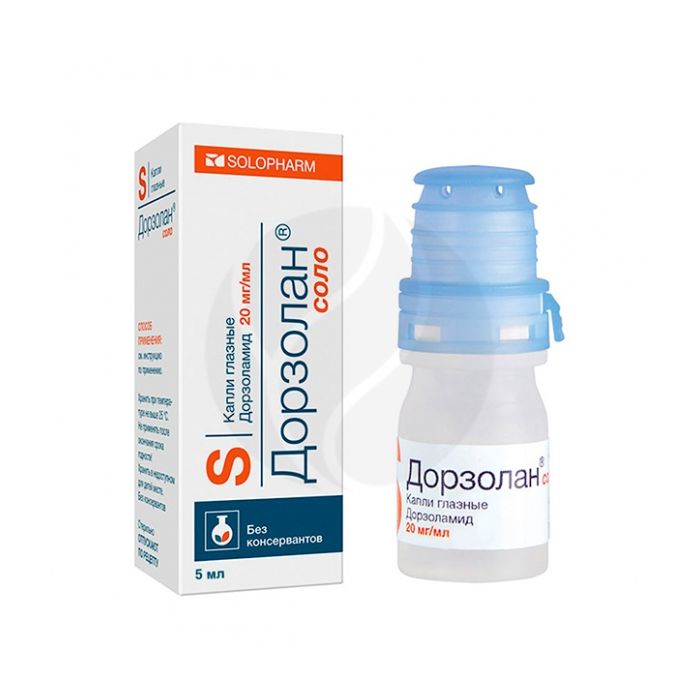Dorzolan Solo eye drops 2%, 5 ml
Expiration Date: 05/2027
Russian Pharmacy name:
Дорзолан Соло капли глазные 2%, 5 мл
It is applied topically 2-3 times / day (as monotherapy or in combination with beta-blockers).
Eye drops in the form of a transparent, colorless or almost colorless, slightly viscous solution.
1 ml of dorzolamide hydrochloride 22.26 mg,
which corresponds to the content of dorzolamide 20 mg
Excipients: sodium citrate dihydrate - 2.94 mg, sodium hyaluronate - 1.8 mg, mannitol - 23 mg, sodium benzoate - 2 mg, sodium hydroxide solution 1M or hydrochloric acid solution 1M - up to pH 5.0-6.0, water d / i - up to 1 ml.
Chronic renal failure (CC less than 30 ml / min),
hyperchloremic acidosis,
pregnancy,
lactation period (breastfeeding),
children and adolescents up to 18 years old,
simultaneous oral administration of carbonic anhydrase inhibitors,
hypersensitivity to dorzolamide.
pharmachologic effect
Antiglaucoma agent, carbonic anhydrase inhibitor. Inhibition of carbonic anhydrase in the ciliary body reduces the formation of HCO3- ions, followed by a slowdown in the transport of sodium and fluid, which leads to a decrease in the secretion of intraocular fluid.
Pharmacokinetics
When applied topically, dorzolamide enters the systemic circulation. When used as a course, due to selective binding with carbonic anhydrase II, it accumulates in erythrocytes. In this case, very low concentrations of the unchanged active substance are determined in the blood plasma. Dorzolamide is metabolized to form a single N-desethyl metabolite, which also accumulates in erythrocytes.
Plasma protein binding of dorzolamide is about 33%.
It is excreted mainly in the urine as an unchanged substance and metabolite.
After the end of the administration of dorzolamide, the process of leaching from erythrocytes is non-linear: at the beginning, the concentration of the active substance decreases rapidly, then excretion slows down, while T1 / 2 is 4 months.
Side effect
Local reactions: burning, paresthesia, itching in the eyes, lacrimation, blurred vision, irritation and swelling of the eyelids, conjunctivitis, superficial punctate keratitis, blepharitis, photophobia; rarely - iridocyclitis, an increase in the thickness of the cornea, allergic reactions, hypotension of the eye, retinal detachment in patients after antiglaucomatous operations.
Systemic reactions: bitterness in the mouth, nausea, headache, asthenia, nephrourolithiasis, malignant exudative erythema (Stevens-Johnson syndrome), toxic epidermal necrolysis (Lyell's syndrome), agranulocytosis, aplastic anemia, skin rashes.
Application during pregnancy and lactation
The use of dorzolamide during pregnancy and lactation (breastfeeding) is contraindicated.
Application for violations of liver function
Use with caution for violations of liver function.
Application for impaired renal function
Contraindicated in severe renal failure (CC less than 30 ml / min).
Application in children
Should not be used in children.
special instructions
It is used with caution in patients with diabetes mellitus, liver failure, corneal diseases, after antiglaucomatous operations (risk of eye hypotension, retinal detachment).
Influence on the ability to drive vehicles and use mechanisms
Since dorzolamide can cause dizziness and nausea, during the treatment period, potentially hazardous activities associated with the need for concentration and increased speed of psychomotor reactions should be avoided.
Drug interactions
Anti-glaucoma drugs (beta-blockers, pilocarpine, dipivefrin, carbachol) enhance the effect of dorzolamide.
With simultaneous use with acetazolamide, the risk of developing systemic side effects increases.
Possible increased toxicity when taking acetylsalicylic acid in high doses.

